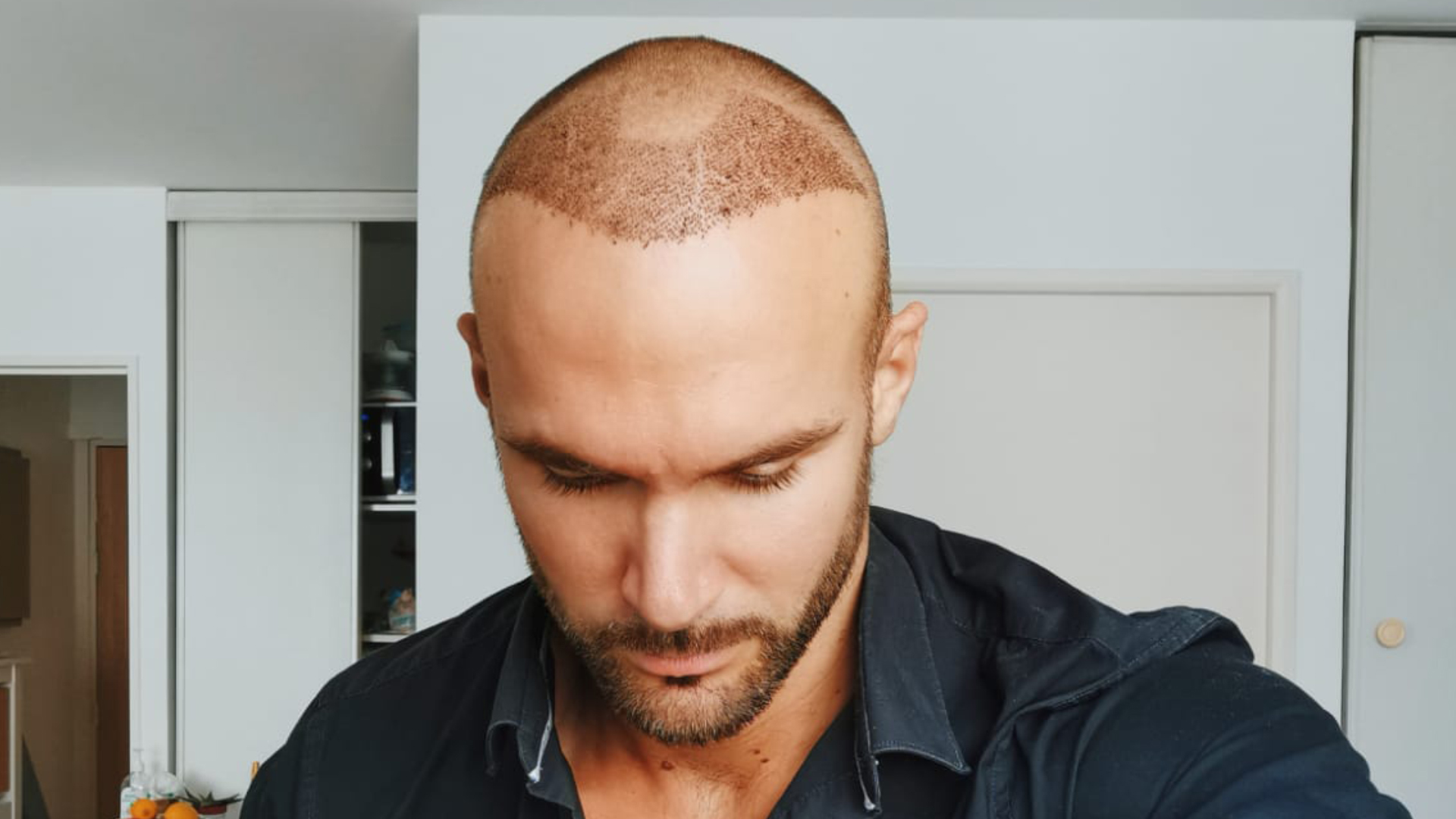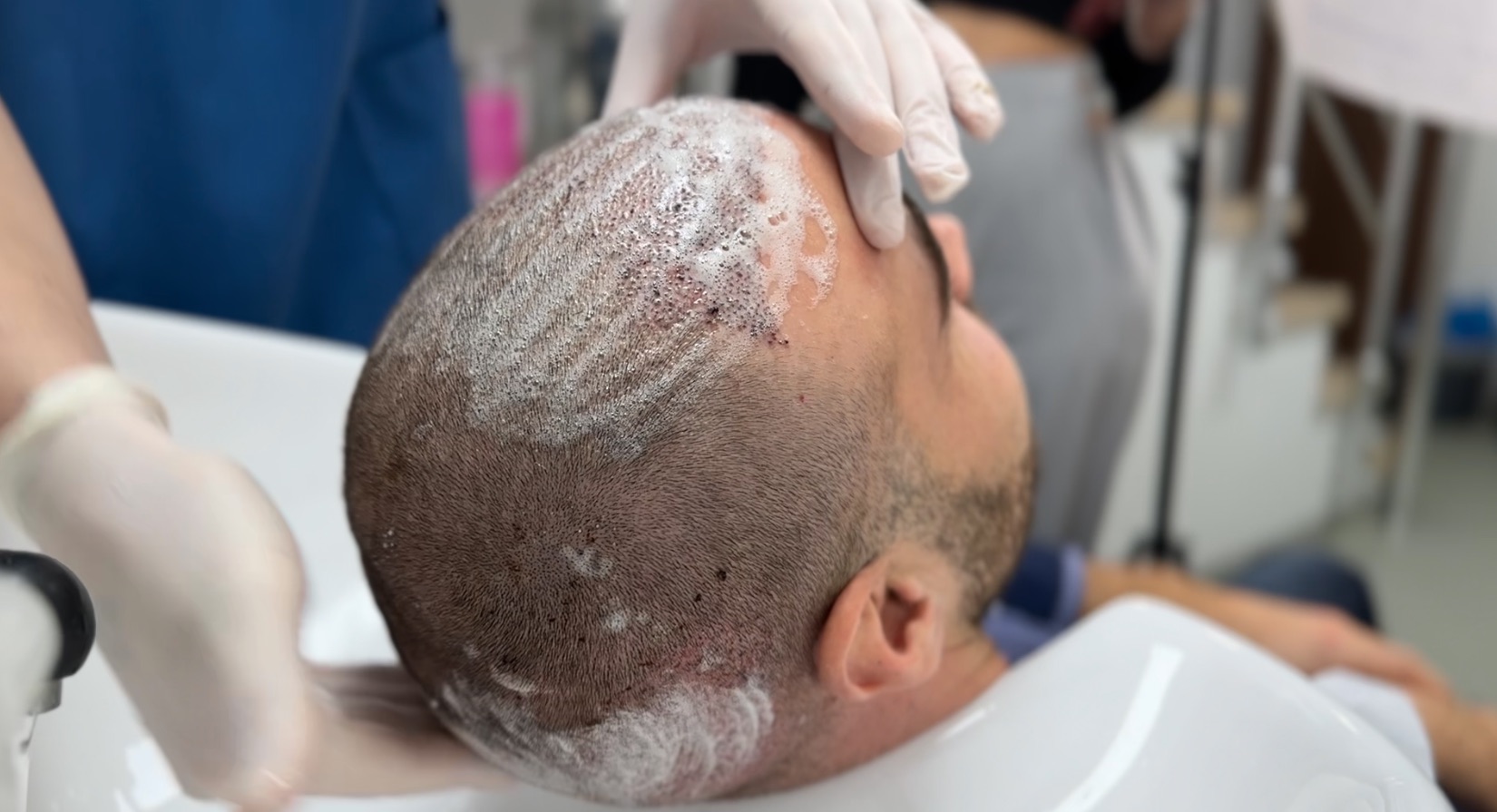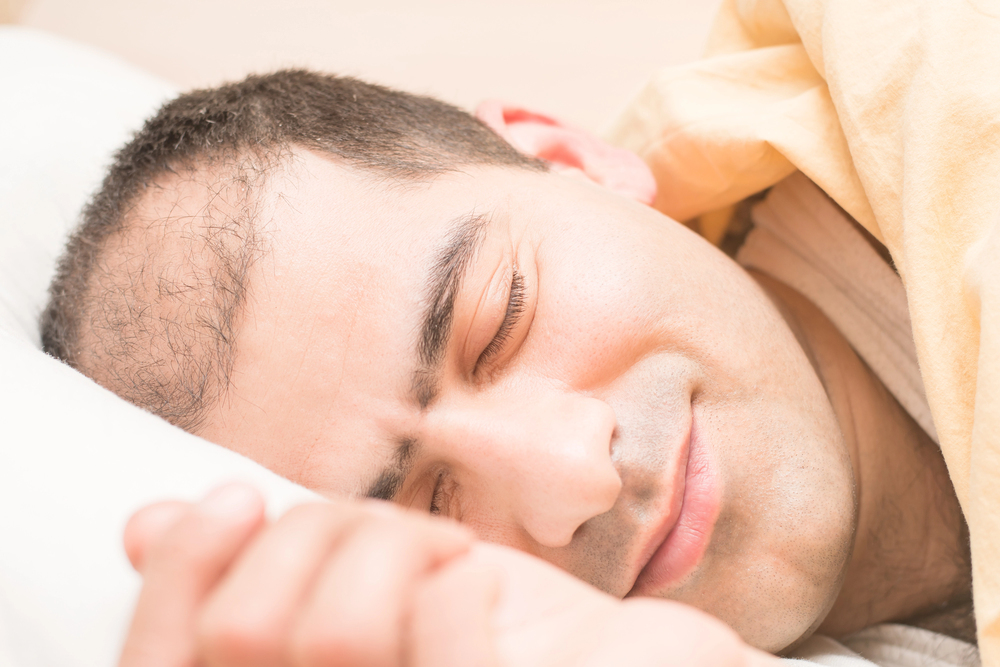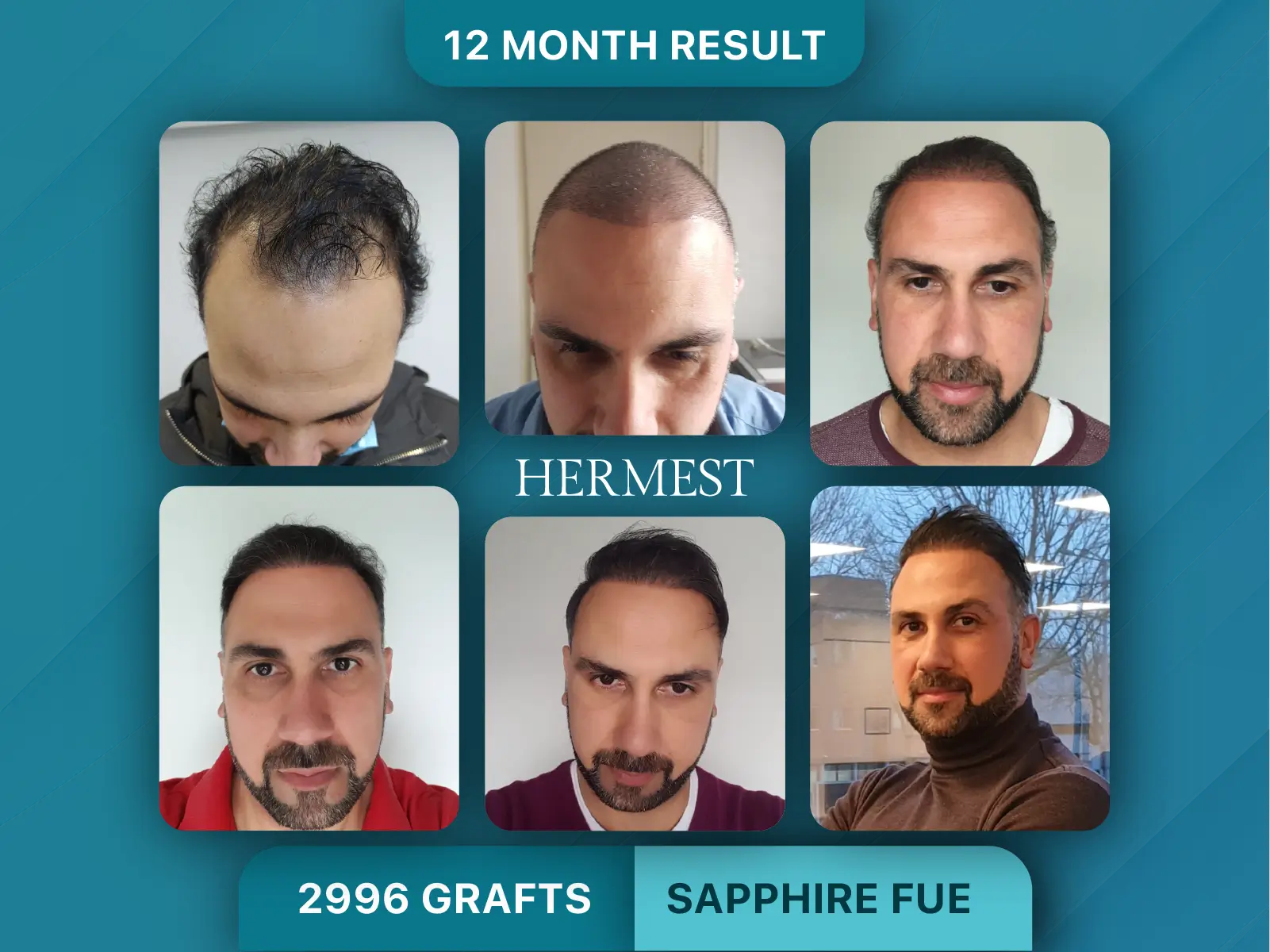The hair transplant surgery is over. You’ve made it through the big day, the needles, the waiting, the excitement. Now you’re standing in front of the mirror, trying to figure out how to sleep, how to wash your hair, and what’s “normal” when the itching starts.
If that sounds familiar, you’re not the only one. Most people say the hardest part of a hair transplant isn’t the operation, it’s the aftercare. Because here’s the truth: once you leave the clinic, the real work begins.
According to the Cleveland Clinic (2024) and StatPearls medical review, how you treat your scalp in the first few weeks directly affects graft survival, healing speed, and long-term density. Those new follicles are fragile, they need air, blood flow, and a calm environment to thrive.
In this full guide, we’ll try to explore everything that keeps those new grafts safe, day by day, week by week, from how to sleep and wash your hair to when it’s finally safe to hit the gym, travel, or even enjoy a glass of wine again.
By the end, you’ll know exactly what to do (and what to avoid) so your new hair grows stronger, thicker, and healthier, just the way it was meant to.
At a Glance: Maintaining Your Hair After Transplant
Caring for your hair after a transplant isn’t complicated, but it’s consistent. Every small habit adds up. If there’s one rule, it’s this: don’t rush your recovery. Your scalp knows what it’s doing. You just need to support it.
Here’s the short version you’ll want to remember:
- First 2 days: Keep it dry and untouched. Sleep upright.
- Day 3–10: Gentle washing only. No scratching, heat, or tight hats.
- Weeks 2–4: Expect shedding (normal). Avoid sweat and sun.
- Months 2–6: Be patient — this is when roots strengthen.
- Months 6–12: Growth takes shape; maintain PRP, meds, and healthy habits.
- Full results: Around 12–18 months, with consistency and care.
The clinics and medical sources agree that aftercare is 50% of your success. Following timelines, using approved products, and keeping your scalp healthy will protect every graft you invested in.
Day-by-Day Aftercare Timeline (Week 1 → Month 12+)
Every scalp heals on its own schedule, but the timeline below follows what major institutions such as the NHS, Cleveland Clinic, and StatPearls (2024) describe as the average recovery path for both FUE and DHI patients. Think of it less as a checklist and more as a rhythm: rest early, protect often, and let time do the rest.

Days 1–2: The Protection Phase
You’ll leave the clinic with a light dressing over the donor area and a saline spray to keep grafts hydrated. Your job: don’t touch anything. No washing yet, no scratching, no hats, and no leaning forward for too long. Sleep with your head elevated at about 45°, ideally using a neck pillow to prevent contact with the grafts.
Mild swelling and tenderness are normal; the NHS recommends using prescribed pain relief or cold compresses (on the forehead only, never the grafts).
Days 3–6: The Gentle Wash Window
This is when the healing surface starts to dry and itch, which means it’s time to start gentle washing. Use lukewarm water and a mild, pH-balanced shampoo like baby shampoo or the one your clinic provides. Pour water slowly from a cup, or use a low-pressure shower flow from a distance. Pat dry with soft tissues, never rub.
By day six, you can expect small scabs and flakes to form. Let them fall off naturally.
According to Cleveland Clinic (2024), premature rubbing can dislodge grafts still stabilizing in the scalp’s upper layer.
Days 7–14: Shedding & Settling
Around the end of week one, redness fades, and you may gently massage the donor area to ease tightness. Most people can return to work (especially desk jobs) after day seven.
Between day 10–14, the tiny crusts over each graft soften and start to fall. Don’t force it, washing twice daily is enough. For FUT patients, this is also when stitches are removed (usually day 10–12).
Weeks 3–4: Shock Loss Arrives
This is the emotional dip. Some of your transplanted hairs will fall out and yes, it can look alarming. But it’s completely normal. According to StatPearls (2024), this “telogen shedding” is part of the natural cycle: the graft enters a rest phase before regrowing stronger.
Dr. Ahmet Murat (Hermest Hair Clinic):
“When you see hair falling, remember: it’s not failure, it’s the follicle rebooting.”
Avoid alcohol, smoking, and strenuous workouts during this phase. Your scalp is still regaining blood flow balance.
Months 2–3: Dormancy & Patience
The scalp may look unchanged or even thinner. This “ugly duckling” stage is where patience is tested. Continue gentle washing and mild massage to keep the skin flexible.
You can start using topical minoxidil (if advised) from month two, which helps reactivate follicles and improve density over time.
Months 4–6: The Comeback Begins
Small, fine hairs start to appear. They’re soft, thin, and sometimes colorless at first, like baby hair. Most patients see 30–50 % visible growth by the end of month six. You can resume all normal activities, including swimming, gym, and sun exposure (with SPF 50 protection).
According to the Cleveland Clinic, consistency now matters most, avoid stress, maintain hydration, and eat protein-rich foods to support keratin production.
Months 7–12: Maturity & Maintenance
Your new hair thickens, darkens, and gains texture. Most density appears between month eight and twelve, though full results can take up to 18 months.
Now’s also the time to discuss PRP (platelet-rich plasma) or low-level laser therapy (LLLT) with your doctor for long-term support.
Washing, Sleeping & Skin Care

It sounds simple but how you wash, sleep, and care for your skin can make or break those first weeks. Every tiny graft needs oxygen, stability, and a clean surface to root properly. The way you handle your scalp in this stage decides how strong your new hair will grow later.
How to Wash Your Hair (and When to Start)
According to the NHS (2024) and Cleveland Clinic, your first wash usually happens on day three after surgery, never sooner. Here’s the right way to do it:
- Skip the showerhead. Instead, pour lukewarm water from a cup, gently over your scalp.
- Use a mild shampoo, ideally sulfate-free, pH-balanced, or the one your surgeon recommended.
- Don’t rub. Foam the shampoo between your palms, tap it softly onto the grafts, and let it sit 30 seconds.
- Rinse slowly using gravity, not pressure.
- Air dry or pat gently with a soft towel or sterile gauze.
Avoid hot water, direct pressure, or hair dryers for at least two weeks. If itching starts, lightly spray sterile saline instead of scratching, it soothes the area and keeps grafts moist.
Dr. Gökhan Bilgin (Smile Hair Clinic):
“Think of your scalp like freshly planted soil. You water it, you don’t blast it.”
Sleeping After a Hair Transplant
The first 7 nights are about protecting the grafts from friction and swelling. Sleep on your back, propped up at a 30–45° angle using two pillows or a neck support. No turning, no sleeping on your side or stomach.

From week two onward, once the grafts have fully adhered, you can return to your usual position, just keep your pillowcase clean and change it daily.
If swelling creeps down your forehead, that’s normal, the Cleveland Clinic notes it peaks around day three or four, then fades naturally.
Skin & Scalp Care
Your scalp will feel dry, maybe tight, or even flaky. That’s all part of the healing cycle. Here’s how to help it recover without interfering with grafts:
- Use saline mist 3–4 times daily for the first week to hydrate the grafts.
- Moisturize gently with aloe-based or panthenol lotions on the donor area only.
- Avoid sun exposure for at least four weeks. If you must go out, wear a loose hat or apply SPF 50 once approved.
- No cosmetic products, oils, or styling gels before month one.
Exercise, Work, Travel, Sun & Heat

Most patients feel ready to get back to normal life within days, and that’s where many go wrong. Your grafts might look stable, but beneath the skin, they’re still connecting to new blood vessels. Move too fast, sweat too early, or bake your scalp in the sun, and you risk undoing the entire process.
According to Cleveland Clinic (2024), your scalp needs 10–14 days of minimal stress, no sweating, no bending pressure, no friction. After that, you can start easing back into your usual rhythm. Here’s how to do it safely:
Returning to Work
- Desk jobs: Usually fine after 3–5 days if swelling is minimal.
- Physical labor: Wait at least 10–14 days, or longer for FUT patients.
- Outdoor work: Add a breathable hat (loose-fitting, clean, cotton).
Exercise & Sports
- Weeks 1–2: Only light walking. Avoid bending, lifting, or anything that raises your heart rate.
- Weeks 3–4: Add light gym workouts, but skip sweating-heavy activities like running, HIIT, or hot yoga.
- Week 4+: You can slowly return to full exercise, depending on your surgeon’s green light.
The NHS (2024) warns that sweat can increase infection risk, while friction from helmets or tight gear may disturb grafts before they anchor.
Traveling After a Hair Transplant
You can fly after 5–7 days, but choose aisle seats if possible, easier for head movement and less risk of bumping. If your clinic offers an ozone or PRP session, it’s worth staying an extra day or two before leaving. On planes, the cabin air is dry, so use your saline spray to prevent itching and dehydration.
According to StatPearls (2024), changes in cabin pressure do not harm grafts, what matters is hygiene and hydration.
Sun & Heat Exposure
This is one of the biggest recovery mistakes. Direct sunlight before week 4 can burn healing tissue, delay regrowth, or cause permanent pigmentation. No tanning beds, saunas, steam rooms, or hot baths during this time.
From week 5 onward, use SPF 50+ sunscreen daily, especially if you’re in sunny climates like Istanbul, Antalya, or Dubai. If you need to be outdoors early, use a loose cotton cap or parasol.
Quick Recap
| Activity | Safe Timeline | Notes |
|---|---|---|
| Desk work | 3–5 days | Keep scalp dry, avoid tight hats |
| Flights | 5–7 days | Stay hydrated, use saline spray |
| Light exercise | 2 weeks | Avoid sweat and strain |
| Heavy training | 4 weeks | Only after crusts fully gone |
| Sun exposure | 4 weeks | SPF 50 or hat required |
| Sauna / steam / pool | 4–6 weeks | Risk of infection early on |
Medications & Therapies That Protect Results
A successful hair transplant doesn’t end when you leave the clinic. It continues quietly in your bathroom mirror every morning, with the choices you make. The grafts are new, but the biology is the same. If you had pattern hair loss before surgery, that tendency still exists.
That’s why doctors often prescribe supporting medications and therapies to keep both transplanted and native hair healthy.
According to StatPearls (2024) and the Cleveland Clinic, the right post-op routine usually includes three key layers: medications, growth stimulators, and regenerative support.
Medications That Keep Native Hair from Thinning

- Finasteride (1 mg/day) works by reducing DHT, the hormone responsible for male-pattern baldness. Clinical data show it lowers hair loss progression by over 80 % in men within 12 months. Many surgeons recommend restarting it around week 2–3, once the scalp has healed.
- Minoxidil (2 %–5 %) stimulates blood flow to hair follicles. It’s applied once or twice daily starting after the second month, when grafts are secure. Expect mild shedding early on — it’s the follicle resetting itself.
Dr. Ahmet Murat (Hermest Hair Clinic):
“Finasteride protects what you had. Minoxidil boosts what you just gained.”
PRP (Platelet-Rich Plasma)

Think of PRP as a biological “booster shot” for your scalp. Your blood is drawn, spun in a centrifuge, and the plasma, rich in growth factors, is injected into the scalp to stimulate healing and new growth.
According to PubMed clinical reviews (2023), PRP can increase graft survival by 10–15 % and improve density over six months. Most of the best hair transplant clinics in Turkey recommend:
- Three sessions (one per month after surgery)
- Then quarterly top-ups for maintenance
Dr. Gökhan Bilgin (Smile Hair Clinic):
“PRP is like watering your garden every season, it keeps the roots alive.”
Low-Level Laser Therapy (LLLT)
Devices like LaserBand 82 or Capillus Pro use red-light wavelengths (650–680 nm) to energize follicles. The Cleveland Clinic (2024) notes consistent use 3–4 times per week can enhance thickness and reduce miniaturization.
LLLT works best as a long-term companion to Finasteride or Minoxidil, think of it as a fitness routine for your scalp.
Nutrition & Lifestyle Support
Healthy grafts love protein, iron, and vitamin D. Avoid nicotine and alcohol in the first month, both restrict blood flow and delay healing. Hydration and regular sleep aren’t just wellness habits; they directly affect oxygen delivery to your follicles.
FUE vs. Sapphire FUE vs. DHI — Aftercare Differences
Every technique follows the same healing biology, follicles need oxygen, blood supply, and protection. But how you care for them right after surgery changes slightly depending on how they were implanted.
Here’s what matters most for each:
FUE (Follicular Unit Extraction)
FUE is the global standard, that grafts are extracted one by one and implanted into pre-made channels. After FUE, the donor area usually feels tight and slightly sore for a few days.
Aftercare focus:
- First wash: Start on day 3–5, using a cup-pour rinse (never direct shower pressure).
- Sleeping: Keep your head elevated for 5 nights to reduce swelling.
- Donor zone: Apply antibiotic ointment or panthenol foam for 3–5 days.
- Scabs: Should soften and fall by day 10–12 naturally.
According to Cleveland Clinic (2024), grafts are fully anchored by day 10, which means gentle washing and light exercise are safe afterward.
Dr. Ahmet Murat (Hermest Hair Clinic):
“With FUE, less is more. The cleaner and calmer your scalp, the higher your survival rate.”
Sapphire FUE
Sapphire FUE is technically FUE, but it uses sapphire blades instead of steel to make finer, smoother channels. The incision quality improves healing speed and reduces scabbing, but care rules remain strict.
Aftercare focus:
- Less crusting: thanks to the smoother sapphire cuts, scabs often clear by day 8–9.
- Washing: You can start gentle rinses around day 3, but still avoid pressure or rubbing.
- Sun protection: The incisions are shallower, so early exposure can irritate easily — SPF 50 from week 3 is key.
A StatPearls (2024) review notes that sapphire incisions shorten recovery by up to 20%, but only if patients follow a clean, dry-care routine during week one.
DHI (Direct Hair Implantation)
DHI skips channel creation by using an implanter pen, placing grafts directly into the scalp. That precision allows denser packing and faster healing, but it also means the grafts sit closer to the surface early on.
Aftercare focus:
- No touch zone: For the first 5 days, even slight contact can shift a graft.
- Washing: Usually postponed until day 5, with soft foam shampoo and slow water pouring.
- Hat use: Wait at least 7 days; friction can dislodge shallow-placed grafts.
- Exercise: Avoid anything that causes sweating for 2 full weeks.
The International Society of Hair Restoration Surgery (ISHRS) emphasizes that DHI demands stricter hygiene in the early phase, since implantation depth is shallower, the follicles are more exposed to external irritation.
Dr. Gökhan Bilgin (Smile Hair Clinic):
“DHI gives precision, but it also tests patience. Your scalp needs calm, not confidence.”
At a Glance
| Technique | First Wash | Donor Healing | Graft Stability | Exercise Allowed | Scabs Gone |
|---|---|---|---|---|---|
| FUE | Day 3–5 | 7–10 days | Day 10 | Week 2 | Day 10–12 |
| Sapphire FUE | Day 3 | 6–8 days | Day 9 | Week 2 | Day 8–9 |
| DHI | Day 5 | 7–9 days | Day 12 | Week 3 | Day 10–12 |
Dr. Güncel Öztürk (HairNeva Clinic):
“Technique changes the details, discipline decides the outcome.”
Shedding, Shock Loss & Regrowth Timeline
Every patient goes through it that uneasy moment when the new hair starts falling out. You look in the mirror and wonder if it all failed. It didn’t. What you’re seeing is your scalp resetting.

According to StatPearls (2024) and the Cleveland Clinic, almost everyone experiences some form of shock loss between weeks 2 and 6. The grafts stay; only the visible hairs are shed. It’s part of the body’s natural shift from the telogen (resting) phase back into anagen (growth).
Weeks 2–6 – The Shedding Stage
Tiny hairs start to fall, often mixed with light flakes. It may look dramatic, sometimes 60 to 80 percent of transplanted hairs — but it’s purely cosmetic. Your follicles remain alive under the skin, building new roots. Avoid panic-driven moves like rubbing, over-washing, or restarting minoxidil too early. Let the scalp breathe.
Dr. Ahmet Murat (Hermest Hair Clinic):
“Shock loss feels like a step back, but it’s your scalp preparing for a stronger comeback.”
Months 2–4 – The Dormant Phase
This is the hardest mental stretch, the “nothing’s happening” period. Your scalp may look thin again, almost like before surgery. Stay patient. Inside the dermis, new cells are dividing and forming secondary blood vessels.
According to NHS guidance, itching and mild redness are normal; avoid scratching or heavy hats that trap heat.
Months 4–6 – The First Sprouts
Fine, wispy hairs begin to emerge, sometimes lighter in color or softer in texture. These early sprouts often grow in random directions at first; your stylist can trim them gently after month 6. By the end of this stage, you’ll see around 30–50 percent visible density, confirmed by multiple Cleveland Clinic studies.
Months 7–12 – Thickening & Texturing
The real transformation starts here. Hairs become darker, thicker, and gain natural volume. You can style them, cut them, even color them if the scalp feels fully healed. Consistency with finasteride, minoxidil, or PRP sessions now helps preserve native hair and balance density.
Months 12–18 – Final Results
By this point, about 90–95 percent of your new hair has appeared. The texture evens out, and transplanted strands blend seamlessly with existing ones. A follow-up PRP or maintenance plan with your surgeon helps lock in long-term stability.
Dr. Gökhan Bilgin (Smile Hair Clinic):
“What you see at twelve months is great, what you see at eighteen is maturity.”
Red Flags & When to Call Your Surgeon
Hair transplants rarely go wrong when aftercare is followed. Still, sometimes the scalp signals that something’s off, and it’s better to listen early.
Most symptoms like mild redness, itching, or temporary numbness are part of the normal healing process. But a few signs require professional attention. According to the NHS and Cleveland Clinic, the main point is watching for changes that worsen after day three instead of improving.
Persistent Pain or Swelling Beyond Day 5
A little soreness is normal, but pain that keeps intensifying may signal inflammation or infection. Swelling that moves below the eyes or causes tightness around the temples shouldn’t be ignored. Cold compresses can help in the first days, but if symptoms persist, reach out to your clinic.
Dr. Güncel Öztürk (HairNeva Clinic):
“Your scalp speaks early, pain is never just pain after day five.”
Pus, Discharge, or Foul Odor
A healthy scalp heals clean. If you notice yellow discharge, wet scabs, or a bad smell, it may point to infection. The StatPearls clinical review (2024) notes these are early warning signs of bacterial buildup around grafts or donor follicles. Antibiotics clear most cases quickly if caught early.
Bleeding That Doesn’t Stop with Light Pressure
Minor spotting is normal during washing, but steady bleeding from either the donor or recipient zone is not. Use sterile gauze and press gently for 10 minutes, if it continues, call your doctor.
Visible Graft Loss or Open Spots
Sometimes patients accidentally scratch or bump their head during sleep, dislodging a few grafts. If you see small open holes or missing patches, your surgeon can evaluate whether re-implantation or PRP support is needed.
Excessive Itching, Burning, or Crusting
Mild itching is part of healing, but intense irritation, oozing, or thick scabs after day 10 can mean infection or allergy, sometimes from overusing topical sprays. The NHS (2024) advises switching to saline only until reviewed by your clinic.
Fever or Chills
Any fever above 38°C (100.4°F) after surgery should be reported immediately. It could indicate infection spreading through soft tissue, something doctors can manage easily with early intervention.
Severe Hair Loss Beyond the Transplanted Area
It’s rare but possible for non-transplanted areas to thin out from temporary shock (called diffuse effluvium). If hair continues falling past month 3, a doctor may recommend adjusting medication or adding PRP or Minoxidil support.
Dr. Ahmet Murat (Hermest Hair Clinic):
“You can’t control healing, but you can control how fast you respond.”
When in Doubt, Contact, Don’t Guess
Even the best transplant can’t protect against human worry. If something feels wrong, color change, pain, sudden shedding, or unusual swelling, send photos to your clinic. Modern follow-up systems allow remote checks within minutes, saving grafts and peace of mind.
Important Questions & Answers
When can I wash my hair after a transplant?
Most clinics recommend washing after day 3, using a gentle pour-and-foam technique with lukewarm water. Avoid direct pressure and hot showers for the first 10 days.
Is it normal for new hair to fall out after surgery?
Yes, about 60–80 % of transplanted hairs shed between weeks 2 and 6. The follicles stay in place and start regrowing around month 3.
When can I go back to work?
Desk jobs are fine after 3–5 days; physically demanding work usually waits 10–14 days.
Can I drink alcohol after a hair transplant?
Wait at least 10 days. Alcohol thins the blood and can slow graft healing.
When can I exercise or lift weights again?
Light walking is safe after a week. Resume gym workouts slowly after 2–3 weeks, avoiding sweat and strain early on.
How long until I see results?
New hairs appear around month 4, thicken by month 8, and full results take 12–18 months.
When can I wear a hat or helmet?
Loose hats are fine after a week. Helmets or tight caps should wait 3–4 weeks until grafts are secure.
Do I need medications after a hair transplant?
Most doctors recommend finasteride (1 mg daily) and minoxidil (topical 2–5 %) to protect native hair and strengthen new growth.
Can I travel right after surgery?
Flying is safe after 5–7 days. Keep your scalp hydrated with saline spray and avoid direct AC air.
What if my scalp feels itchy or dry?
Light itching means healing. Use saline spray or your clinic’s recommended lotion, never scratch).
References
- National Health Service (NHS). Hair Transplant: What to Expect. 2024.
- Cleveland Clinic. Hair Transplant: Procedure, Recovery & Results. 2024.
- StatPearls Publishing. Hair Transplantation. NCBI Bookshelf, 2024.
- PubMed Central (PMC11401157). Hair Transplantation: Current Practice & Post-Operative Care. 2024.
- International Society of Hair Restoration Surgery (ISHRS). Aftercare & Recovery Recommendations. 2024.